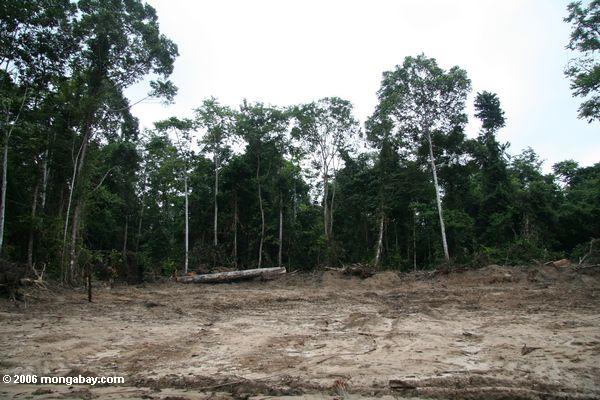- The illegal timber trade costs legal forest products industry actors billions of dollars in lost revenue, so governments and businesses are developing various tools to more effectively track timber.
- Tools that use smartphones, big data, and even high-tech pixie dust help institutions collect and share data, manage wood inventories, track timber movements through the supply chain, evaluate the traceability and compliance of timber sellers, and promote transparency at all levels.
- These technologies and systems help governments and businesses better track timber supplies and prevent illegally sourced timber from entering supply chains, though they must also translate data into action.
The illegal timber trade creates problems for everyone. Governments lose valuable revenue and natural resources. Indonesia’s Corruption Eradication Commission reported that the country lost $9 billion in revenue to the illegal timber trade between 2003 and 2014. Meanwhile, businesses sourcing legal timber lose profits and competitiveness to illegal timber supplies sold at lower prices.
So governments and businesses are starting to do more to improve timber traceability, including adopting new and existing technologies that can help track timber, manage information, and eventually, help combat illegal logging.
WRI, Instituto Nacional de Bosques (INAB) of Guatemala and IUCN Mesoamerica, with support from USAID, the European Commission, and FAO, recently hosted a workshop in Antigua, Guatemala to explore technological applications for improving forest information management and traceability in timber supply chains. Participants discussed some of the most cutting-edge technologies available today or on the horizon.

Technologies that track wood’s roots
Some technologies target the tracking of timber as it moves through the supply chain to guarantee authenticity of the timber’s origin, including:
- Stardust is a dust-like material that can be sprayed onto wood and detected only with a hand-held device. Stardust has the potential to be applied to timber and pulp and paper products as a cheaper alternative to barcodes, radio-frequency identification (RFID) and other tracking technologies. Greenwood, an organization that connects buyers with producers of high-quality wood products from sustainably harvested trees, is now pilot testing Stardust’s application to some of their wood supplies.
- TreeTAG is an emerging smartphone-based supply chain traceability system developed by Earth Observation Systems that tracks the location of logs transported from the forest to the mill. It requires all authorized personnel—from those cutting trees to those processing logs—to report activities and volumes, raising alerts when there is suspicious activity. Only trees previously authorized for logging can enter the system. Earth Observation Systems is currently working with Sociedad Civil Custodios de la Selva (CUSTOSEL), a sustainable mahogany producer, to pilot test the system on wood used by Bedell Guitars.
- Several government agencies are also developing systems for supply chain traceability.
- The Forestry Commission of Ghana is piloting Ghana Wood Tracking System (GWTS), developed by Ata Marie, a data platform that centralizes all formerly paper-based documentation, and allows users like auditors to upload information from their phones and computers.
- The Guatemalan Forest Service is developing SEINEF (Sistema Electrónico de Información de Empresas Forestales – Forest Enterprises Electronic Information System), a web platform that requires actors along the supply chain to enter volume and authorization information. The system allows government officials and law enforcement officers to follow the flow of timber products from the forest to buyers and identify discrepancies in volumes, species and products reported.
- The Brazilian Forest Service also uses a traceability and information management system that not only tracks trees as they are logged and sawn into timber but also uses remote sensing data to monitor forest management.

Other technologies focus on aggregating, analyzing, visualizing and verifying supply chain information:
- Global Traceability Systems’ Radix Tree is a platform that enables buyers to collect information from suppliers to establish a chain of custody. Radix Tree also performs legality risk assessments based on information provided, a required step for compliance with the European Union Timber Regulation (EUTR). Furthermore, it also helps users manage their inventory of products and shipments, provide secure encryption and private data storage and import data from multiple formats. Among its users are Unilever and Bureau Veritas, a leading global certification body.
- BVRio’s Responsible Timber Exchange uses big data to assess whether potential sellers are complying with U.S. and European legal wood requirements. To assess the risk of illegality, the database draws information not only from official documentation, such as logging permits and sawmill operating licenses, but also from legal records of forest owners, loggers and even forest engineers involved in a shipment. With this information, the exchange allows buyers to evaluate sellers based on the traceability of their timber and compliance with specific legal, environmental, social and labor criteria. A similar system is under development in Brazil, led by the nonprofit Imaflora.
These technologies and systems can substantially bolster the efforts of governments and businesses to better track timber supplies and prevent illegally sourced timber from entering supply chains.
However, while timber traceability technologies and platforms can provide much needed information, it’s only worthwhile if governments and businesses translate this data into action. For governments, that means eradicating corruption, implementing systems that work for all stakeholders, and allocating more funding and resources to enforcement. For businesses, it means working with suppliers to gather information and communicate legal sourcing policies, as well as cutting ties with bad actors.
